These 11 Unlikely Foods Trigger Your Brain's Starvation Defenses & Make You Overweight, Tired & Depressed
Contrary to what the diet industry wants you to believe, the ingredients in or the way the 11 foods below are processed — even though they're low in fat and sugar and are low-calorie — trigger your brain's starvation defenses. This makes your body store more fat, burn less fat — making you feel tired and lethargic in order to conserve energy and fat stores. This also alters your brain chemistry to make you feel depressed.
To learn more about each food, mouse over each image with your curser.
Frozen Low-Fat Meals
Quick, portion-controlled, and portable, lower calorie frozen meals seem like an ideal solution when trying to lose weight.
Most frozen meals are low in protein and vegetables, use refined grains instead of whole, and contain high levels of sodium. The end result is a high sodium meal that’s low in fiber, protein, and vitamins.
The excess sodium damages the membranes of your cells. Fat is burned in your cells and cells with damaged membranes becomes impaired and burn less fat.
These dinners are convenient and time saving. So here's a solution for an ideal microwavable meal: leftovers from your fat burning dinner prepared from recipes in "The New Neuropsychology of Weight Control' program) dinner. When you’ve got extra dinner servings, portion out lunch for the next day or two in portable storage containers. Or, make an extra batch of a favorite casserole or soup on the weekend, and freeze single-servings for days when you need them.
If you’re in a pinch and need to buy a frozen meal, then look for one that feature whole grains and have at least 4g of fiber and 12g of protein. Pair with a side salad, fresh fruit, or steamed veggies for an extra boost of nutrients and to keep you full and satisfied.
Canned Soup
They’re convenient in a pinch, but here are three reasons why low-calorie canned soups shouldn’t be a regular part of your diet: sodium, BPA, and taste. All soups are high in sodium, but canned ones have more (often around 600 to 1000mg per cup). In addition, many cans are lined with BPA, a chemical that research potentially links to some cancers and other diseases. Finally, it always tastes like it came from a can. We’d all choose homemade over that preservative-tinged flavor if we could, right?
Here’s a better alternative: make large batches of your favorite soup loaded with veggies, protein, whole grains and/or beans, and limit the amount of salt you toss in. You'll find delicious soup recipes in "The New Neuropsychology of Weight Control."
Instant Oatmeal
Oatmeal is a great whole-grain energy source. But, if you’re relying on flavored oatmeal packets it can also be a sweet bowl of refined carbs that raise your blood sugar levels, leave you starving midmorning and trigger your brain's starvation defense mechanism. Instant oatmeal is highly refined so it’s lower in fiber and protein and usually has added sugar. None of these qualities set your morning up for fat loss success.
Instead, cook and refrigerate a batch of steel cut or old-fashioned oats that you can simply reheat and flavor with fruit and toasted nuts.
Diet Soda & Soft Drinks
The one thing that you thought was safe when you're trying to loose excess body fat is now considered a major cause of obesity and diabetes. Diet soda drinkers are at higher risk for developing diabetes and metabolic syndrome ( triggering your brain's starvation defense systems) than those who drink sugared beverages. This promotes abdominal fat and prevents fat loss.
Artificial sweeteners confuse your body chemically. Your brain's fat regulating mechanism (the hypothalamus) constantly monitors the levels of sweetness in your blood. When sweet levels get to high or concentrated it triggers what's called a "cephalic response." Your blood sugar levels increase to dangerous levels, your body manufacturers excess insulin, your cells become insulin resistant (insulin is needed in the cells to burn fat), you don't burn fat for energy, you get fatter and your appetite for fatty and sugary (refined carbohydrates) food dramatically increases. This ultimately results in chronic obesity , pre-diabetes and ultimately Type-2 Adult-Onset Diabetes.
Here's the catch. Artificial sweeteners used in diet drinks are 1 million times more concentrated in sweetness that regular sugar and thus, when consumed, dramatically trigger your brain's cephalic response.
If you insist on drinking soda you're better off drinking soda with cane sugar. It's not an issue of calories but of concentration of sweetness that makes the difference.
The sodium in all soft drinks raises blood pressure and damages your body's cells membranes impairing your ability to convert fat into energy.
Your best bet is to skip diet and regular sodas altogether. Have a homemade fruit/berry/herb infused water when you want liquid options other than plain water. If you can’t imagine your day without diet soda, then work your way down to one can per day. Get plenty of water as well, and be aware of the effects that the diet soda might have on your health, body fat, appetite and eating habits.
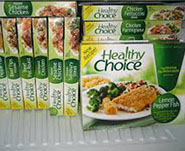
Frozen Low-Fat Meals
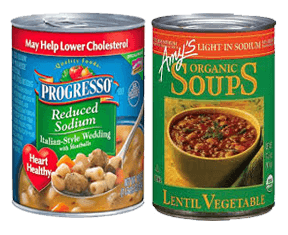
Canned Soup
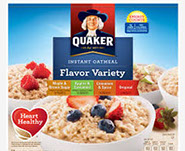
Instant Oatmeal
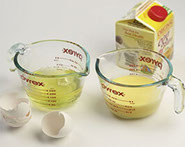
Egg Substitutes
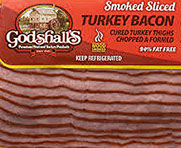
Turkey Bacon
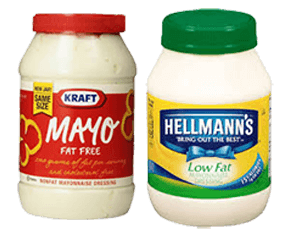
Low-Fat Mayonaise
Diet Soda & Soft Drinks
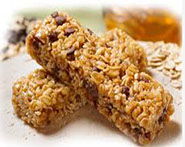
Granola, Granola /Cereal Bars
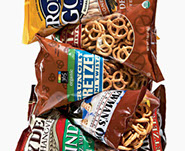
Pretzels & Rice Cakes
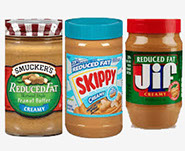
Reduced Fat Peanut Butter
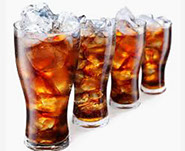
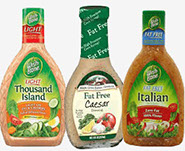
Fat-Free Salad Dressing
Egg Substitutes
Egg substitutes became the fat-free, cholesterol-free answer when high cholesterol foods like the egg were thought to be a primary cause of heart disease. Research now shows it’s saturated fat, not cholesterol, that’s the culprit. In fact, the American Heart Association says it’s okay to eat one egg a day. But many still choose egg subs to save calories and fat.
Here’s why you should not use an egg substitute and choose an egg instead: One egg is high in quality, nutrient-rich protein, and it’s one of the few breakfast foods that can keep you satisfied you until lunch. One study even found that people trying to lose weight who ate eggs for breakfast consumed fewer refined and fatty foods later in the day than those who ate other breakfast foods. If one won’t fill you, scramble 1 whole egg with 1 to 2 egg whites or pair with fresh fruit or whole grains.
Turkey Bacon
Real bacon is sometimes too tempting to pass up. However, turkey bacon doesn’t always provide the fat savings you might expect. Most bacon turkey brands contain the same amount of fat as center-cut pork bacon, sugar and even more sodium.
So can you lose weight, and eat bacon? Yes, it's possible. The key is choosing a leaner, high-flavor cut (such as center-cut bacon) and staying on top of portion size. Choose real bacon, especially if a little bit of the real thing keeps you content, which is key to staying with your fat loss.
Fat-Free Salad Dressing
Salads are near-perfect food—high in complex fiber-rich (god) carbohydrates, full of nutrients, and filling. But choosing the right dressing is tricky. Many people assume fat-free dressings are the best choice. But something has to take the place of the fat, and in the case of fat-free dressings it’s typically sweeteners. The lack of fat combined with the added sugar in the dressing makes you hungry again in an hour or two. Plus, the taste of fat-free dressings leaves a lot to be desired.
Your best choice when dieting is to skip the fat-free versions, opt for a light (50% less fat) or regular dressing, and measure the serving. A little healthy fat over fiber-rich salad veggies provides satiety; top it with a little protein, and you’re good for hours. But there’s another reason to avoid the fat-free dressing. Research shows that you can’t absorb many nutrients from the salad veggies in the digestive tract without fat.
We recommend a simple dressing made of high-quality cold-pressed olive oil (or avocado or walnut oil), apple cider/balsamic vinegar and/or a squeeze of juice from a ripe lemon.
Low-Fat Mayonnaise
Sure the fat got slashed, but what replaced it was modified food starch, high fructose corn syrup, a touch of soybean oil, and lots of chemical preservatives. Saving some fat isn’t worth the sugar and chemicals it adds to your diet—never mind that these spreads don’t taste much like real mayonnaise either.
So what to spread on your sandwich? Choose a light mayo with around 50% less fat and made with real eggs and olive oil and without corn syrup. Or, use just a touch of real mayo. It won't hurt you. Another alternative: try slices of avocado or another spread such as guacamole, hummus, or pesto instead. You’ll get healthy fat while enjoying their rich flavors.
Reduced Fat Peanut Butter
If the thought of eating full-fat peanut butter while trying to lose fat makes you nervous, you’re not alone. There’s no way you could possibly lose weight eating something with 15g to 17g of fat, right? Many grab the lower fat option thinking it’s the smarter choice. Compare the labels though. Two tablespoons of reduced-fat peanut butter has twice the amount of sugar and fillers when compared to two tablespoons of the regular version. This difference is due to the added sugar and fillers to replace the fat.
Avoid the reduced fat peanut butter, and buy full-fat peanut and nut butters ( almond, cashew) instead. Consuming these higher-fat foods won’t halt fat loss if you don't overdue it. In fact, they may even give you an edge.
Eating peanut butter in moderation gives you more satiety compared to eating lower-fat snacks, and the fat and protein in peanut butter curbs your appetite and prevents overeating later on. Take a teaspoon of peanut butter 30-minutes before bedtime and it will help you sleep better.
Granola, Granola Bars, Cereal BarsBaked oats with dried fruit, nuts, and a touch of dark chocolate, granola bars seem like the picture of health, until you look at the Nutrition Facts. Sure, they may have whole grains and healthy fats, but nutritionally, most look more like candy bars thanks to lots of added sugar and little protein. Their biggest threat to fat loss? The lack of satiety they provide as a snack, and the blood sugar spike-then-crash from the added sugar. Choose one of these granola-like substitutes instead: a small handful of nuts and piece of fresh fruit, a small handful of nuts and a small dark chocolate square, or a small bowl of hot oatmeal. We also have a "Pulse" recipe that substitutes as a granola/cereal bar type of treat but is very healthy. Fill out the form below and we'll email the recipe to you:
Pretzels & Rice Cakes
Pretzels and rice cakes were once considered a near-perfect weight loss food . And while there’s really nothing blatantly wrong with pretzels and rice cakes, there’s not much great to say about them either. Usually made from refined grains, pretzels and rice cakes are low in protein, fiber, fat, vitamins, and minerals, which is why they leave you hungry and wanting more. They're also quickly absorbed into your blood to raise blood sugar levels which triggers your brain's starvation defenses.
Smarter snack options will have a combination of whole grains or fiber, protein, and some fat. When you’re craving a salty crunch, opt instead for a handful of nuts, hummus with baby carrots, or apple slices with cheese cubes. If you can’t imagine giving up pretzels or rice cakes, then pair them with protein and fiber-rich foods. Top a rice cake or apple slices with peanut or nut butter, toss mini pretzel twists in a bag with almonds, or grab some dried fruit for a snack mix
What's
Inside


If you overdue it on sweets and fattening snacks make yourself work to satisfy your cravings. Don't keep them in the house, but make yourself go out to get them. If your sugar fix source is in walking distance that would be the best way to get there. If not, a drive in the car will do.
The more hassle tasty treats are to get, the less likely you are to eat them. As a result your sweets consumption will decline without making you feel deprived.
